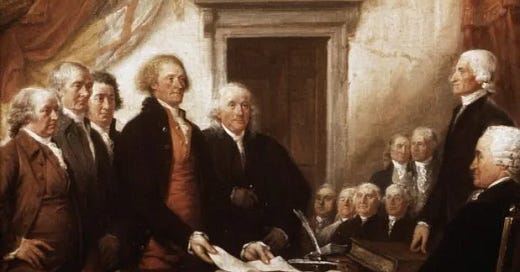What Happened at the Signing of the Declaration of Independence
The signing of the Declaration of Independence marked a pivotal moment in the history of the United States. On July 4, 1776, the Second Continental Congress officially adopted the Declaration of Independence, formally declaring the American colonies’ intention to sever their ties with British rule.
Although July 4 is celebrated as Independence Day, most delegates did not sign the Declaration until 2 August 1776. Thomas Jefferson primarily drafted the document, and it outlined the colonies’ grievances against King George III while asserting their right to self-government.
The act of signing the Declaration was a bold act of defiance. By putting their names on the document, the signers committed to a cause that the British Crown would consider treason—a decision that placed their lives, property, and reputations at grave risk.
Who Signed and When
The first person to sign was John Hancock, President of the Continental Congress. He signed on 4 July 1776 in large, bold script—reportedly so that King George III could read it “without his spectacles.” His flamboyant signature became iconic, which is why “John Hancock” remains a slang term for “signature” in the U.S.
The last person believed to have signed was Thomas McKean of Delaware. Unlike most delegates who signed in early August 1776, McKean likely added his name months or even years later, possibly as late as 1781. His delayed signing was due to political and military duties, as well as ongoing debates over the document’s final form and signatories.
What Happened After the Signing
After the Declaration was signed, many of the signers took on critical roles in the fight for independence and the formation of the new nation:
John Adams became a diplomat in Europe and later the second President of the United States.
Thomas Jefferson served as Governor of Virginia, authored important legislation, and eventually became President.
Thomas Nelson Jr. led Virginia militia forces.
William Whipple served as a general in the New Hampshire militia.
Several signers worked as diplomats abroad to secure alliances and financial support. Among them, Benjamin Franklin, John Adams, and Thomas Jefferson were instrumental in forging relationships with France and the Netherlands.
Many endured personal losses due to their revolutionary stance:
Richard Stockton was captured and imprisoned by the British.
Francis Lewis had his home destroyed and his wife imprisoned.
From Declaration to Constitution
Of the 56 signers of the Declaration, four also helped draft or sign the U.S. Constitution in 1787. Their presence helped ensure that the ideals of the Revolution were reflected in the new framework of government:
Roger Sherman
Benjamin Franklin
James Wilson
George Clymer
The signers of the Declaration didn’t just declare independence—they risked everything to make it a reality. Through military service, diplomatic missions, and leadership at home, they laid the foundation for a new nation, often at significant personal cost.
***
Douglas Pilarski is an award-winning writer and journalist based on the West Coast. His writing resonates with those passionate about luxury goods, exotic cars, horology, tech, food, agriculture, lifestyle, historical events, equestrian and rodeo, and millionaire travel.
To be a more interesting human, subscribe to the Journal Blue Curated.
I welcome your thoughts and feedback.






